Have you ever imagined having a plant that feeds on insects?
Carnivorous plants are true masterpieces of evolution, adapted to survive in poor soils with a surprising trick: capturing and digesting live prey.
Besides being fascinating, these species have developed unique capture mechanisms, such as suction traps, sticky tentacles, slippery pitchers, and even underground structures. They are adapted to extreme environments and show how creative—and somewhat ruthless—nature can be.
And the best part? Many carnivorous plants can be grown at home!
Some are perfect for beginners, like the Venus flytrap and Sundew. Others, like Nepenthes or Heliamphora, require more dedication and experience.
In this article, you’ll discover the 8 most incredible genera of carnivorous plants, understand how their traps work, where they live in nature, and how to bring an exotic touch to your green collection.
Dionaea muscipula (Venus Flytrap)

The Dionaea muscipula, better known as the Venus flytrap, is probably the most famous carnivorous plant in the world—and for good reason.
With its intriguing appearance, mobile traps, and almost “animal-like” behavior, it seems to challenge everything we know about the plant kingdom. This small plant is capable of capturing and digesting insects with surprising precision.
Each Venus flytrap trap is formed by two modified “leaves” with edges full of marginal cilia—structures that resemble teeth and interlock when closing. Inside the trap are sensory hairs, responsible for detecting the touch of prey. If an insect touches two of these hairs within 20 seconds, the trap closes instantly, like a hunting reflex.
This mechanism is an ingenious adaptation: in its natural habitat—acidic, nutrient-poor bogs of North Carolina (USA)—the only way to obtain nitrogen and phosphorus is by digesting small animals.
Darwin didn’t hide his admiration for the species and went so far as to state:
“The Dionaea is one of the most wonderful plants in the world.”
— Charles Darwin, 1875
🔍 Read the complete Venus flytrap growing guide
Drosera (Sundew)
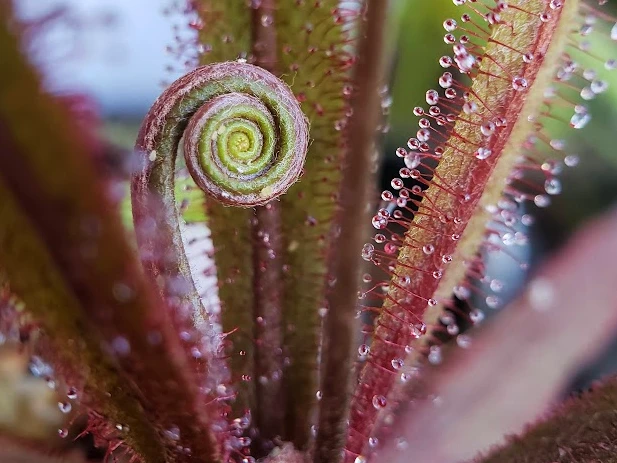
The Drosera, popularly known as the sundew, is a carnivorous plant that enchants with its delicate appearance and the ingenious strategy it uses to capture prey.
Its leaves are covered with small glandular tentacles that secrete a sticky, shiny substance, similar to morning dew—hence its name. This “sticky trap” attracts unsuspecting insects which, upon landing, become stuck and are slowly digested by the enzymatic compounds released by the plant.
It’s a fascinating adaptation, especially in environments where the soil is poor in nutrients—such as bogs and marshy regions—forcing the plant to seek alternative sources of nitrogen and phosphorus.
In home cultivation, Drosera requires some specific care:
- Water: preferably use distilled, deionized, or rainwater; if using tap water, only observe the amount of chlorine.
- Substrate: an acidic mixture poor in nutrients, usually composed of peat and perlite, without fertilizers.
- Light: needs plenty of indirect sunlight or gentle full sun, depending on the species.
- Environment: can be grown in pots, mini greenhouses, or open terrariums, as long as there is good ventilation and moderate humidity.
Some species of Drosera, such as Drosera capensis, are ideal for beginners, as they adapt well and are quite resilient. Beyond their ornamental function, these plants offer a true living lesson on adaptation, evolution, and biodiversity.
Growing a sundew is like bringing a living jewel of nature into your home—sensitive, strategic, and absolutely charming.
Nepenthes (Tropical Pitcher Plants)
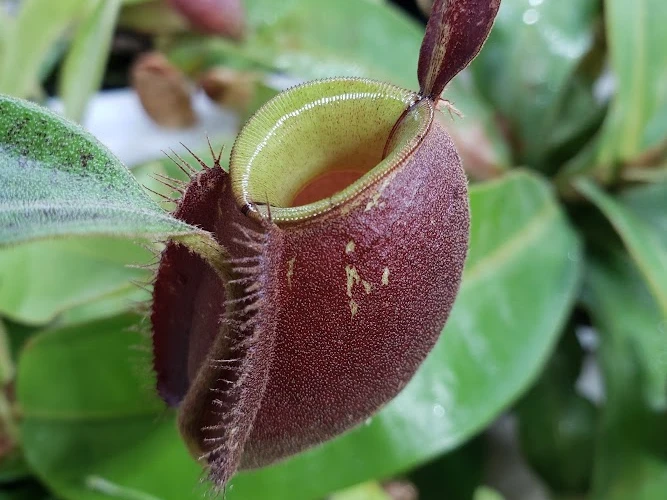
The Nepenthes, known as tropical pitcher plants, are one of the most fascinating genera in the universe of carnivorous plants. Originating mainly from Southeast Asia, Madagascar, and tropical regions of Oceania, these plants evolved to survive in poor soils by creating unique and ingenious structures to capture prey: the famous pitchers.
These pitchers are nothing more than modified extensions of the leaves, in the form of a tube, with a “lid” that prevents excessive rain from entering. Inside, there is a digestive liquid where insects and even small vertebrates fall and are slowly digested. The slippery shape and waxy edges make it difficult for prey to escape, ensuring the plant’s supplementary nutrition.
Unlike other carnivorous plants like Dionaea (quick trap) or Drosera (sticky tentacles), Nepenthes use a passive and extremely efficient strategy. They attract their prey with sweet aromas and nectar, leading them into the pitcher, where the victim ends up submerged in the digestive liquid.
Sarracenia (North American Pitcher Plant)
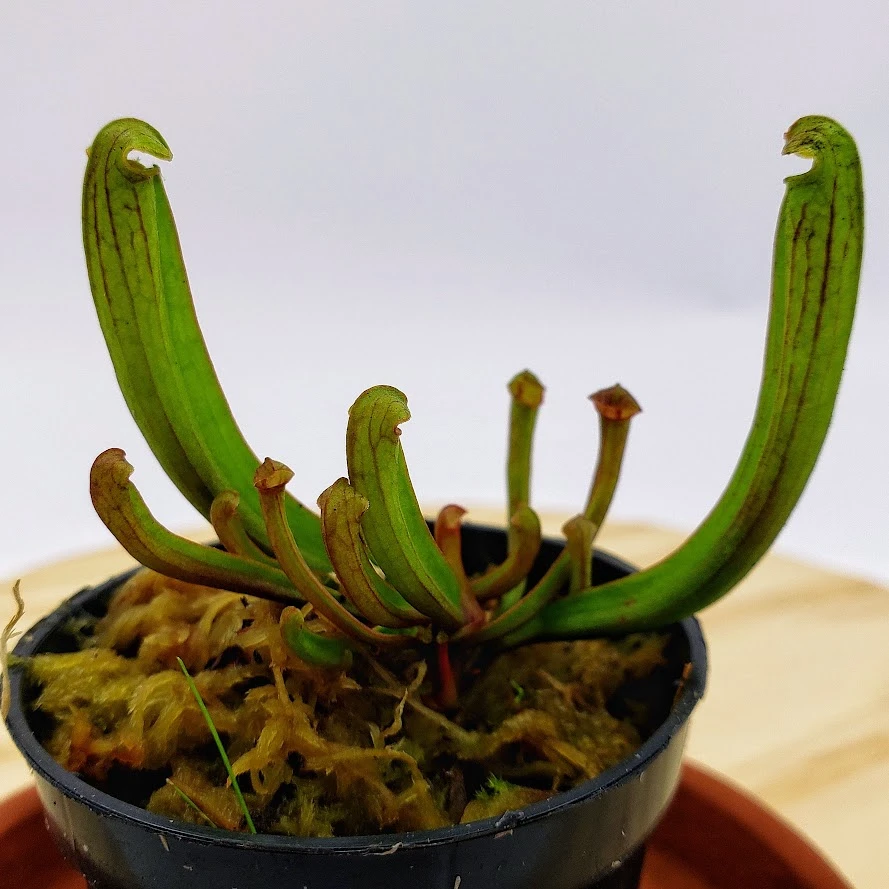
The Sarracenia is a fascinating carnivorous plant, native to the wetlands of North America. Its elongated pitcher shape, combined with vibrant patterns and elegant structures, not only visually enchants but also functions as an efficient trap for unsuspecting insects. It’s a plant that seduces to capture.
The modified leaves of the Sarracenia form deep, slippery tubes that fill with water and digestive enzymes. The upper edge, usually wide and colorful, exhales a slight sweet aroma and produces nectar, attracting flying insects. Once they land on the edge and try to explore the interior, they end up falling into the pitcher. Downward-pointing hairs prevent any escape attempt, leading the victim to a slow and silent digestion at the bottom of the trap.
Each species of the Sarracenia genus presents unique variations. Sarracenia purpurea, for example, has shorter and more robust pitchers, while Sarracenia leucophylla displays white colorations with red veins, appearing almost floral. It’s a plant that combines form and function in an impressive way.
In home cultivation, Sarracenia is one of the most rewarding carnivorous plants. It adapts well to pots exposed to the sun, balconies, and even outdoor planters, as long as it receives abundant light and adequate water. It needs distilled, rain, or reverse osmosis filtered water, and the ideal substrate is a mixture of peat with perlite, always free of fertilizers. It likes constant humidity but detests waterlogged soil.
Another important point is its dormancy phase in winter. The leaves may dry out and the plant may appear inactive, but this rest period is essential for its long-term health. At the end of dormancy, with the arrival of spring, it returns with full force, producing new, more vigorous pitchers.
The Sarracenia is a plant that draws attention wherever it goes. Whether for its sculptural structure, its bold colors, or the efficiency of its traps, it conveys the feeling that nature is a brilliant designer. Growing it means immersing yourself in a universe where beauty and evolutionary strategy meet in harmony.
It also offers a deep connection with the mysteries of botany.
Cephalotus follicularis (Australian Pitcher Plant)
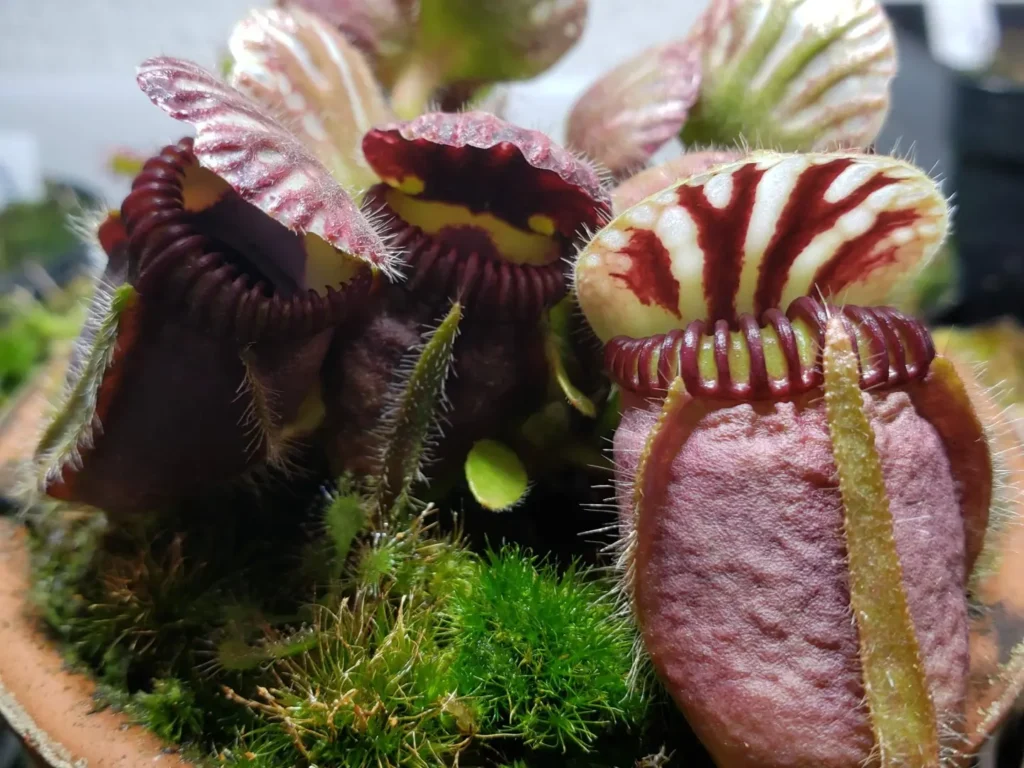
The Cephalotus follicularis, popularly known as the Australian pitcher plant, is a rare jewel among carnivorous plants. Endemic to the southwestern coast of Australia, this small notable enchants collectors with its unique appearance—a fusion of delicacy and predatory efficiency.
Its traps resemble miniature pitchers, with a robust structure, toothed mouth, and an ornamental lid that prevents excessive accumulation of rainwater. The interior of the pitcher contains a viscous digestive liquid where captured insects are slowly decomposed. To attract its prey, the Cephalotus uses a combination of shine, contrasting coloration, and nectar. The slippery shape of the upper edge also contributes to prey easily falling into the trap.
In addition to its traps, it also produces non-carnivorous leaves, which aid in photosynthesis and give balance to the plant. This duality between normal leaves and specialized traps is a fascinating characteristic, rare among carnivorous plants.
In cultivation, Cephalotus requires some specific care, but it’s perfectly possible to grow it at home. It appreciates mild temperatures, well-drained substrate, and moderate humidity. The ideal light is diffuse or gentle sun, especially in the early hours of the day. It’s essential to avoid waterlogging and always use distilled or rainwater, as the plant is sensitive to minerals present in tap water.
Although it grows more slowly than other carnivorous species, Cephalotus rewards patient growers with its sculptural form and intense colors, which vary from green to deep red depending on the light and season. It’s a compact, discreet, and at the same time absolutely mesmerizing plant.
Pinguicula (Butterworts)
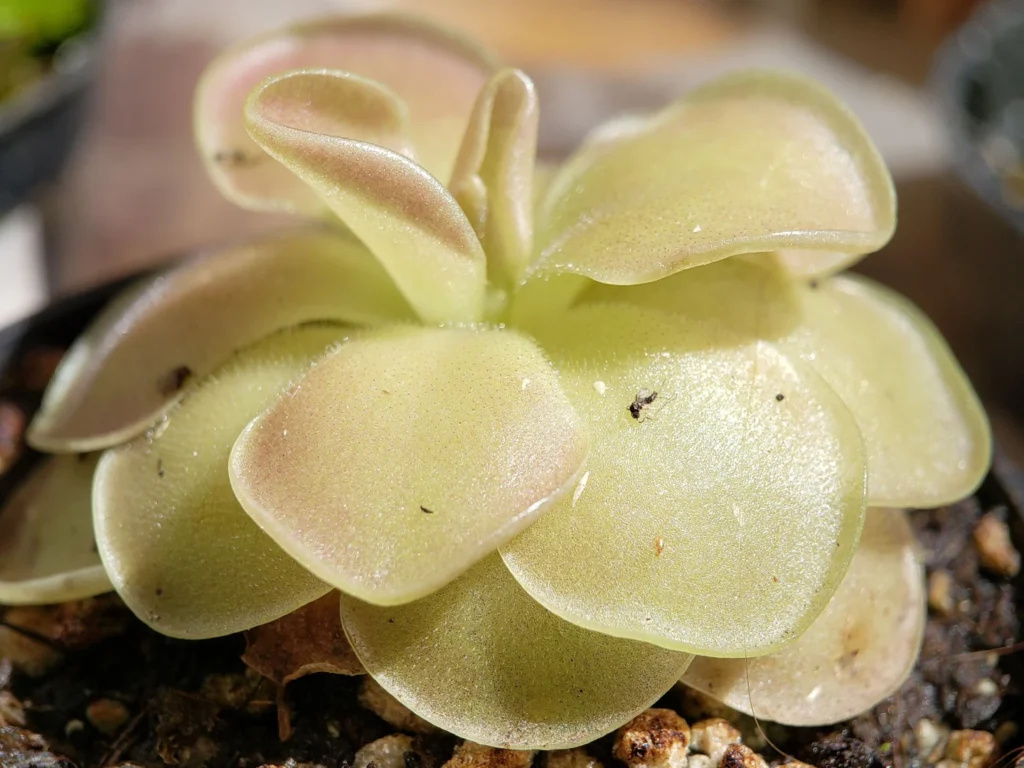
The Pinguicula, known as the butterwort, is a discreet but extremely effective carnivorous plant. Unlike the dramatic traps of Dionaea or the imposing pitchers of Sarracenia, it conquers with simplicity: its soft, shiny leaves function as deadly mats for unsuspecting insects.
These leaves are covered with microscopic glands that secrete a viscous liquid, similar to dew. When an insect lands on the surface, it immediately becomes stuck in this sticky substance. Then, other glands release digestive enzymes that break down the prey’s body, allowing the plant to absorb the nutrients. It’s a passive trap, but highly efficient.
Besides its sticky leaves, Pinguicula enchants with its delicate flowers, which resemble small violets. They emerge at the top of thin stems, usually in shades of lilac, pink, white, or blue, and are a true charm in any carnivorous plant enthusiast’s collection.
Most species are native to the Americas, especially Mexico, although there are also European and Asian varieties. Some prefer humid and shaded locations, others adapt well to limestone rocks or mosses. This diversity makes the Pinguicula genus one of the most versatile and accessible.
In home cultivation, Pinguicula is considered one of the easiest carnivorous plants to care for. It can be grown in small pots, open terrariums, or even on well-lit windowsills. It prefers intense indirect light, well-drained soil (usually a mixture of perlite with sand and a bit of peat), and watering with distilled or rainwater. Unlike other carnivorous plants, Pinguicula doesn’t need waterlogged soil—the ideal is to keep the substrate just slightly moist.
In some species, it’s common for the plant to enter dormancy during winter, exchanging carnivorous leaves for simpler ones. During this period, reduce watering and avoid sudden movements or repotting.
Compact, charming, and functional, Pinguicula is an excellent entry point for those wanting to begin exploring the universe of carnivorous plants. It combines delicate beauty with an efficient and silent capture system, revealing that even the subtlest traps have their place in the botanical jungle.
Genlisea (Corkscrew Plant)
The Genlisea is a carnivorous plant as discreet as it is fascinating. With a delicate appearance, small colorful flowers that resemble open mouths or mini orchids, it hides its true hunting mechanism underground. That’s why it’s also called the corkscrew plant—a reference to the spiral shape of its underground traps.
This genus belongs to the Lentibulariaceae family, the same as Utricularia and Pinguicula. There are more than 30 recognized species, most native to tropical regions of South America and Africa, especially in waterlogged and nutrient-poor soils.
While its flowers enchant on the surface, the real spectacle happens underground. Genlisea has replaced its roots with structures called rhizophylls—hollow, tube-shaped organs, twisted in a spiral, that function as passive traps. These tubes are practically invisible to the naked eye and serve to capture aquatic microorganisms, such as protozoa and bacteria, present in soil water.
The functioning is ingenious: the rhizophylls have inward-pointing hairs, which guide prey toward the interior, preventing any chance of return. When an organism enters, it is slowly directed to a digestive chamber, where the plant absorbs the nutrients. This entire system occurs out of human sight, making Genlisea one of the most subtle yet efficient carnivorous plants in nature.
Besides its unusual capture mechanism, Genlisea is also known for another curious fact: it possesses one of the smallest genomes ever recorded among plants. This makes it a target for scientific research seeking to understand its compact genetic structure and its adaptations to the extreme environment where it lives.
It’s a plant that represents the power of silent evolution. Instead of developing large visual traps like Dionaea or Nepenthes, it opted for an underground strategy, almost invisible—but extremely effective. It shows that beauty can be in hidden details and that, even in challenging environments, life finds creative ways to thrive.
For those who observe only its delicate flowers, it’s difficult to imagine the microscopic world unfolding below the surface. It’s this contrast between aesthetic lightness and functional complexity that makes Genlisea so intriguing.
If there’s a plant that represents the mystery of natural adaptations, it’s this one.
Genlisea is a living reminder that, behind apparent simplicity, there can be extraordinary biological engineering.
Utricularia (Bladderworts)
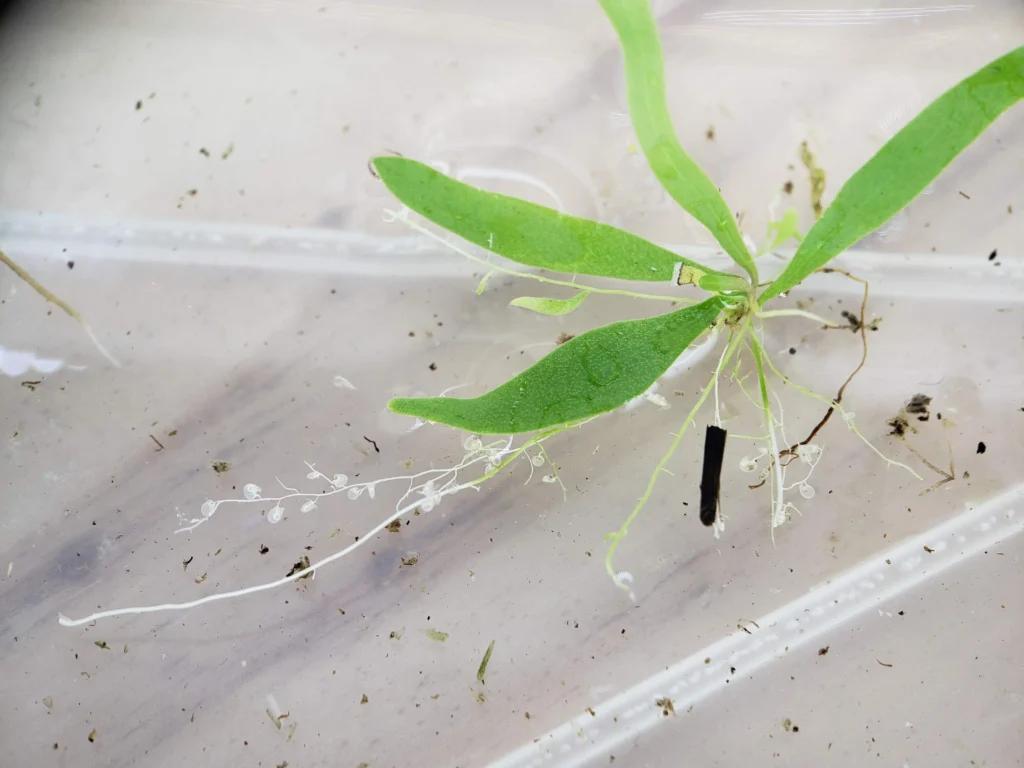
The Utricularia, also known as the bladderwort, is one of the most surprising carnivorous plants in the plant kingdom. Unlike most species that capture prey on the surface, Utricularia has developed a system of underground or submerged traps, almost invisible to the naked eye. These are small bladders called utricles that suck in tiny aquatic or soil prey in a movement as fast as the blink of an eye.
With more than 200 species spread throughout the world, bladderworts can be aquatic, terrestrial, or epiphytic. Some live in lakes and swamps, others grow in moist mosses or even attached to tropical trees. This diversity of habitats makes the Utricularia genus one of the most extensive and adaptable among all carnivorous plants.
Despite the complexity of their traps, Utricularia flowers are delicate and charming. Many resemble small orchids or smiling mouths, with shades that vary from yellow to purple. It’s common for people to fall in love with the flowers even before realizing they’re looking at a carnivorous plant.
In home cultivation, aquatic species require a controlled environment, such as shallow aquariums or pots without drainage, with stagnant water poor in nutrients. Terrestrial ones can be grown in pots with sphagnum moss and perlite, always with constant humidity and diffuse light. Like all carnivorous plants, they need pure water (distilled or rain) and soil free of fertilizers.
The speed and efficiency of Utricularia traps are so remarkable that researchers have studied their movements as a reference for developing suction systems in robotics. It’s a plant that combines delicacy and natural technology on a microscopic scale—almost magical to our eyes.
Conclusion
Growing carnivorous plants at home is like opening a window to the mysteries of wild nature.
Each species brings a unique combination of form, function, and exotic beauty—and at the same time, a delicious challenge for those who love the green world.
Whether starting with a curious Venus flytrap or venturing with a tropical Nepenthes, one thing is certain: these plants will transform your space and your relationship with cultivation.
And remember: more than decoration, they are companions on a botanical journey.
FAQ – Frequently Asked Questions
And you, what do you think of these wonders of nature?
Have you ever grown a carnivorous plant at home? Do you have a favorite? Or are you feeling inspired to start your own collection?
Share your experience in the comments!
👇👇👇
